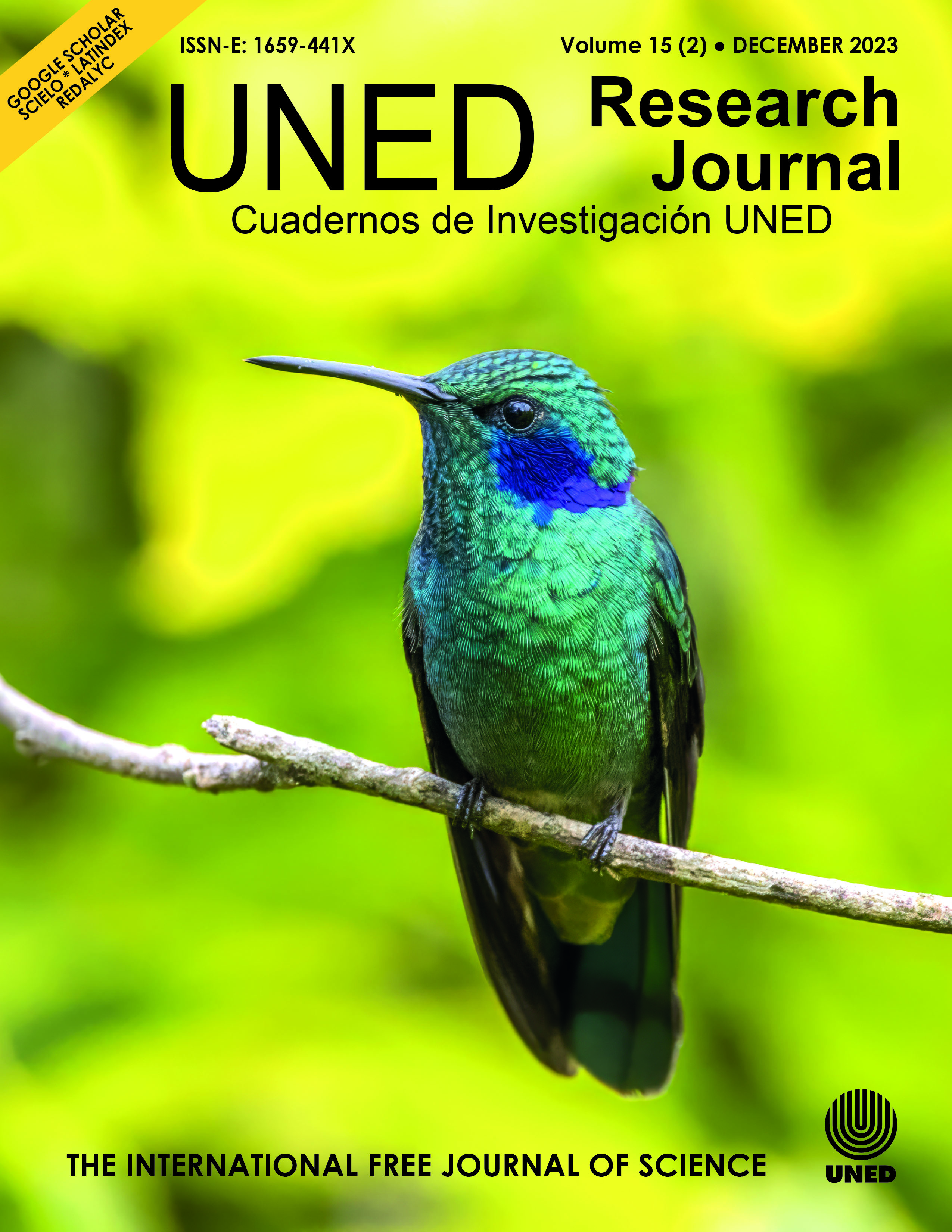Bacterial multi-resistance to antibiotics in water from plant cavities (phytotelms) in a deep tropical forest from Costa Rica
DOI:
https://doi.org/10.22458/urj.v15i2.4675Keywords:
Monteverde cloud forest, urban zone, antimicrobial resistance (AMR), bromeliads tank, understory, deep forestAbstract
Introduction: The spread of antimicrobial resistance in natural environments continues to be reported throughout the world; nevertheless, there is no study about phytotelms (water in the natural cavities of plants) in the deep understory of tropical cloud forests from Costa Rica. Objective: To detect phytotelm antibiotic-resistant bacterial strains in a Costa Rican forest and nearby town. Methods: We used the disk diffusion method to analyze the antimicrobial resistance of 10 gram-negative bacterial strains from phytotelm water collected from 10 bromeliads and 10 heliconias in both sites. Results: Three strains were multidrug resistant to more than three antibiotics in each site, and only one strain was susceptible to all antibiotics. Antibiotic resistance was similar in both environments. Conclusions: Phytotelm can be a rapid, cost-effective, and simple source for detecting antimicrobial resistance in unexplored environments.
References
Benavides‐Gordillo, S., Farjalla, V. F., González, A. L., & Romero, G. Q. (2019). Changes in rainfall level and litter stoichiometry affect aquatic community and ecosystem processes in bromeliad phytotelmata. Freshwater Biology, 64(8), 1357–1368. https://doi.org/10.1111/fwb.13310
Bhullar, K., Waglechner, N., Pawlowski, A., Koteva, K., Banks, E. D., Johnston, M. D., Barton, H. A., & Wright, G. D. (2012). Antibiotic resistance is prevalent in an isolated cave microbiome. PLOS One, 7(4), e34953. https://doi.org/10.1371/journal.pone.0034953
Brighigna, L., Ravanelli, M., Minelli, A., & Ercoli, L. (1997). The use of an epiphyte (Tillandsia caput-medusae morren) as bioindicator of air pollution in Costa Rica. The Science of the Total Environmental, 198(2), 175–180. https://doi.org/10.1016/S0048-9697(97)05447-8
Humphries, R., Bobenchik, A. M., Hindler, J. A., Schuetz, A. N. & McAdam, A. J. (2021). Overview of changes to the clinical and laboratory standards institute performance standards for antimicrobial susceptibility testing, M100, 31st Edition. Journal of Clinical Microbiology, 59(12), e00213–21. https://doi.org/10.1128/JCM.00213-21.
Kraker, M. E. A., Stewardson, A. J., & Harbarth, S. (2016). Will 10 million people die a year due to antimicrobial resistance by 2050? PLOS medicine, 13(11), e1002184. https://doi.org/10.1371/journal.pmed.1002184
Lee, P. R., & Lin, C. (2003). The antibiotic paradox: how the misuse of antibiotics destroys their curative powers (review). Perspectives in Biology and Medicine, 46(4), 603–604. https://doi.org/10.1353/pbm.2003.0088
NOAH. (2016). NOAH responds to the O’Neill review. Veterinary Record, 179(6), 132–132. https://doi.org/10.1136/vr.i4266
O’Neill, J. (2014). Antimicrobial Resistance: Tackling a crisis for the health and wealth of nations. https://goo.by/pUHMs
Ogan, M. T., & Nwiika, D. E. (1993). Studies on the ecology of aquatic bacteria of the lower Niger Delta: Multiple antibiotic resistance among the standard plate count organisms. The Journal of applied bacteriology, 74(5), 595–602.
Rodríguez-Pérez, H., Borrel, G., Leroy, C., Carrias, J.-F., Corbara, B., Srivastava, D. S., & Céréghino, R. (2018). Simulated drought regimes reveal community resilience and hydrological thresholds for altered decomposition. Oecologia, 187(1), 267–279. https://doi.org/10.1007/s00442-018-4123-5
Segawa, T., Takeuchi, N., Rivera, A., Yamada, A., Yoshimura, Y., Barcaza, G., Shinbori, K., Motoyama, H., Kohshima, S., & Ushida, K. (2013). Distribution of antibiotic resistance genes in glacier environments. Environmental Microbiology Reports, 5(1), 127–134. https://doi.org/10.1111/1758-2229.12011
von Wintersdorff, C. J. H., Penders, J., van Niekerk, J. M., Mills, N. D., Majumder, S., van Alphen, L. B., Savelkoul, P. H. M., & Wolffs, P. F. G. (2016). Dissemination of antimicrobial resistance in microbial ecosystems through horizontal gene transfer. Frontiers in Microbiology, 7, 173. https://doi.org/10.3389/fmicb.2016.00173
Xie, J., Jin, L., Luo, X., Zhao, Z., & Li, X. (2018). Seasonal disparities in airborne bacteria and associated antibiotic resistance genes in PM2.5 between urban and rural sites. Environmental Science & Technology Letters, 5(2), 74–79. https://doi.org/10.1021/acs.estlett.7b00561
Zhu, G., Wang, X., Yang, T., Su, J., Qin, Y., Wang, S., Gillings, M., Wang, C., Ju, F., Lan, B., Liu, C., Li, H., Long, X.-E., Wang, X., Jetten, M. S. M., Wang, Z., & Zhu, Y.-G. (2021). Air pollution could drive global dissemination of antibiotic resistance genes. The ISME Journal, 15(1), 270-281. https://doi.org/10.1038/s41396-020-00780-2
Published
How to Cite
Issue
Section
License
Copyright (c) 2023 UNED Research Journal

This work is licensed under a Creative Commons Attribution 4.0 International License.
Note: This abstract contains an incorrect copyright due to technical issues. Authors who publish with this journal agree to the following terms: Authors retain copyright and grant the journal right of first publication with the work simultaneously licensed under a Creative Commons Attribution License that allows others to share the work with an acknowledgement of the work's authorship and initial publication in this journal
All journal contents are freely available through a CC BY 4.0 license.
CC BY 4.0 is a Creative Commons: you can copy, modify, distribute, and perform, even for commercial reasons, without asking permission, if you give appropriate credit.
Contents can be reproduced if the source and copyright are acknowledged according to the Open Access license CC BY 4.0. Self-storage in preprint servers and repositories is allowed for all versions. We encourage authors to publish raw data and data logs in public repositories and to include the links with all drafts so that reviewers and readers can consult them at any time.
The journal is financed by public funds via Universidad Estatal a Distancia and editorial independence and ethical compliance are guaranteed by the Board of Editors, UNED. We do not publish paid ads or receive funds from companies.
